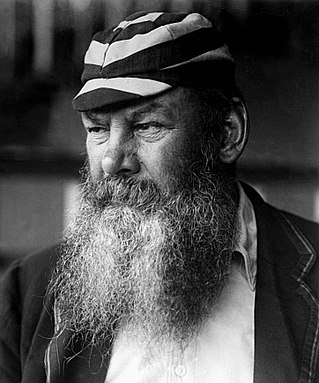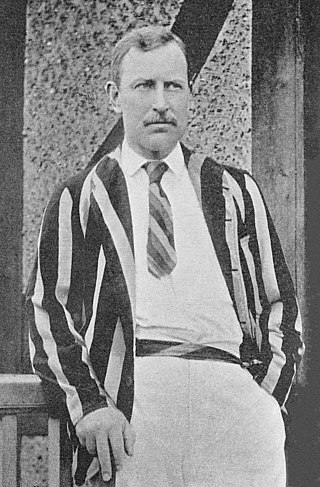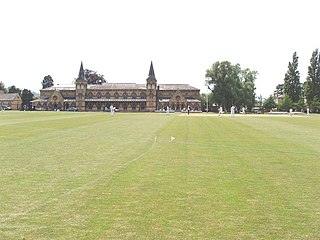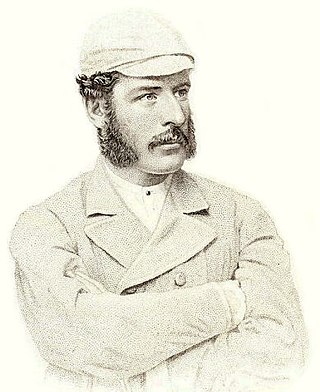Related Research Articles

William Gilbert Grace was an English amateur cricketer who was important in the development of the sport and is widely considered one of its greatest players. He was nominally amateur as a cricketer, but he is said to have made more money from his cricketing activities than any professional cricketer. He was an extremely competitive player and, although he was one of the most famous men in England, he was also one of the most controversial on account of his gamesmanship and moneymaking.

Bransby Beauchamp Cooper was a member of the Australian cricket team that played the inaugural Test match at the Melbourne Cricket Ground in 1877. Cooper was born in Dacca in what was then British India in 1844. He played first-class cricket as an amateur in England for Middlesex and Kent County Cricket Clubs before moving to Australia where he played for Victoria cricket team. He was a right hand batsman and wicket-keeper and the first Indian-born cricketer to play Test cricket.

Alfred Perry "Bunny" Lucas was an English first-class cricketer from 1874 to 1907, playing for Cambridge University, Surrey, Middlesex and Essex. He also played five Test matches for the England cricket team.

George Frederick Grace was an English first-class cricketer active from 1866 to 1880 who played for Gloucestershire and the United South of England Eleven (USEE). He played in one retrospectively recognised Test match for England. He was born in Downend, near Bristol and died in Basingstoke, Hampshire. A right-handed batsman who bowled right arm fast roundarm, he appeared in 195 matches that are generally rated first-class for statistical purposes. In these matches, Grace scored 6,906 runs with a highest score of 189*. An outstanding fielder and occasional wicket-keeper, he held 170 catches and completed three stumpings. He took 329 wickets with a best performance of eight for 43.

The Prince's Club was a socially exclusive gentlemen's multisports club in London, England. The original 'Prince's Club' was founded in 1853 in Chelsea by George and James Prince and its main sports were rackets and real tennis. Cricket, croquet and lawn tennis were also played. After most of its ground was lost to building developments it closed in 1887. Its successor, the 'New Prince's Club', located in Knightsbridge, opened in 1888 and kept its focus on rackets and real tennis, but no longer had any outdoor sports. In 1896 the Prince's Skating Club was opened. The Prince's Club was in operation until the 1940s.
1878 was the 92nd season of cricket in England since the foundation of the Marylebone Cricket Club (MCC). The first official tour by an Australian team was undertaken, although it played no Test matches. A match at Old Trafford inspired a famous poem.

From May to September in 1878, an Australian cricket team made the inaugural first-class tour of England by a representative overseas side. In October, the Australians played additional matches in the US and Canada on their return journey. The tour followed one made by an England team to Australia in 1876–77, during which the first matches retrospectively given Test match status were played. None of the 1878 matches had international status, nevertheless the tour proved to be such an outstanding financial and sporting success that the future of international cricket was assured.
1868 was the 82nd season of cricket in England since the foundation of Marylebone Cricket Club (MCC). It featured the first organised group of Australian sportspeople to travel overseas, being an all-Aboriginal cricket team.
1871 was the 85th season of cricket in England since the foundation of Marylebone Cricket Club (MCC). Derbyshire County Cricket Club became a first-class club and the last matches were played by Cambridgeshire, who in the days of Bob Carpenter, the first Tom Hayward and George Tarrant had been one of the leading cricket counties.
1876 was the 90th season of cricket in England since the foundation of Marylebone Cricket Club (MCC). Gloucestershire reclaimed the unofficial "Champion County" title. A relatively dry summer and improvements to pitches via the heavy roller saw several batting records broken.

The College Ground is a cricket ground in the grounds of Cheltenham College in Cheltenham, Gloucestershire, England. Gloucestershire County Cricket Club have played more than 300 first-class and more than 70 List A matches there. It also hosted a women's One-Day International between England and Australia in 2005.

John Crossland was an English professional cricketer who played first-class cricket between 1878 and 1887. Crossland was recognised as one of the fastest bowlers in county cricket, but critics generally believed that he threw, rather than bowled the ball, a practice illegal in cricket. Contemporaries suggest that, but for the suspicions over his bowling action, Crossland would have played Test cricket for England.

William Yardley was an English cricketer who played first-class cricket for Kent County Cricket Club from 1868 to 1878 and for Cambridge University from 1869 to 1872. In the early 1870s, only WG Grace was reckoned his superior amongst amateur batsmen. Yardley was also an actor, playwright and drama critic.
Edward D'Oyley Barratt was an English cricketer who primarily played for Surrey in a first-class career that lasted from 1872 to 1886. A left-arm slow roundarm bowler with a remarkable capacity for drift, his most famous achievement was taking all ten wickets in an innings for the Players against the Australians in 1878. On three occasions, he took over 100 wickets in a season. His Wisden obituarist wrote of his bowling, "At his best Barratt was certainly a very fine slow bowler, being able on certain wickets to get more work on the ball than almost any other cricketers of his generation."

James Arthur Bush was an English sportsman who played first-class cricket for Gloucestershire County Cricket Club and represented England at rugby union.
Cornelius Coward was an English cricketer. A talented fielder and right-handed batsman, popularly known as Kerr, Coward played 49 first-class matches for Lancashire County Cricket Club between 1865 and 1876. He scored 1,210 runs in the middle order for Lancashire, before retiring to play club cricket for his home town of Preston – who he also coached – as well as becoming a cricket umpire for 98 matches, a licensed victualler and a teacher at the Roman Catholic institutions of Stonyhurst College in Lancashire and Clongowes Wood College in Ireland.

Crystal Palace Park Cricket Ground was a cricket ground in Crystal Palace in south-east London. It was located in Crystal Palace Park in the shadow of The Crystal Palace. The ground was established on 3 June 1857 and used for first-class cricket between 1864 and 1906.
Walter Raleigh Gilbert was an English amateur cricketer who played first-class cricket for Middlesex and Gloucestershire between 1873 and 1886. A cousin of W. G. Grace, he played for Gloucestershire when, dominated by the Grace family, it was the leading county. Gilbert's best season was 1876, when he scored 205 not out for the county, but he was subsequently less successful. Closely connected with the United South of England Eleven, a professional touring team of which he eventually became secretary, Gilbert was financially affected by a declining interest in such teams. With insufficient income to continue as an amateur he became a professional in 1886, but played only one match before he was caught stealing from teammates in a minor match, ending his first-class career. After serving a 28-day prison sentence Gilbert moved to Canada, where he worked for the Land Titles Office in Calgary while remaining a prominent cricketer. He died aged 70 in 1924, but for nearly 60 years after his death, there seemed to be a conspiracy of silence over his fate.
Following his father's death in December 1871, W. G. Grace increased his involvement with the United South of England Eleven (USEE) in order to provide more income for his mother, with whom he and his younger brother Fred were still living. Grace continued to play regularly for Gloucestershire and Marylebone Cricket Club (MCC) and, when required, by the Gentlemen. In the late summer of 1872, he toured North America with a team of players who all had amateur status. In the 1873 season, he performed his first season "double" of 1,000 runs and 100 wickets.
References
- ↑ Not to be confused with the 18th century Brighton Prince of Wales Ground.
- ↑ "Lennox Gardens". London Gardens Online - Lennox Gardens. London Parks & Gardens Trust. Retrieved 6 November 2018.
- ↑ "Old Prince's Club". The Illustrated Sporting and Dramatic News . 90 (2349): 82–83. 21 September 1918.
- ↑ "Prince's Cricket Club" . Sheffield and Rotherham Independent. British Newspaper Archive. 5 June 1871. p. 4.
- ↑ Lazenby, John (2013). The strangers who came home : the first Australian cricket tour of England, 1878. London: Bloomsbury. pp. 114–121. ISBN 978-1408842874.
- ↑ Cricinfo piece on Tom Box
- ↑ Chelsea: Cremorne Gardens, Old and New London: Volume 5, 1878, pp 84-100.